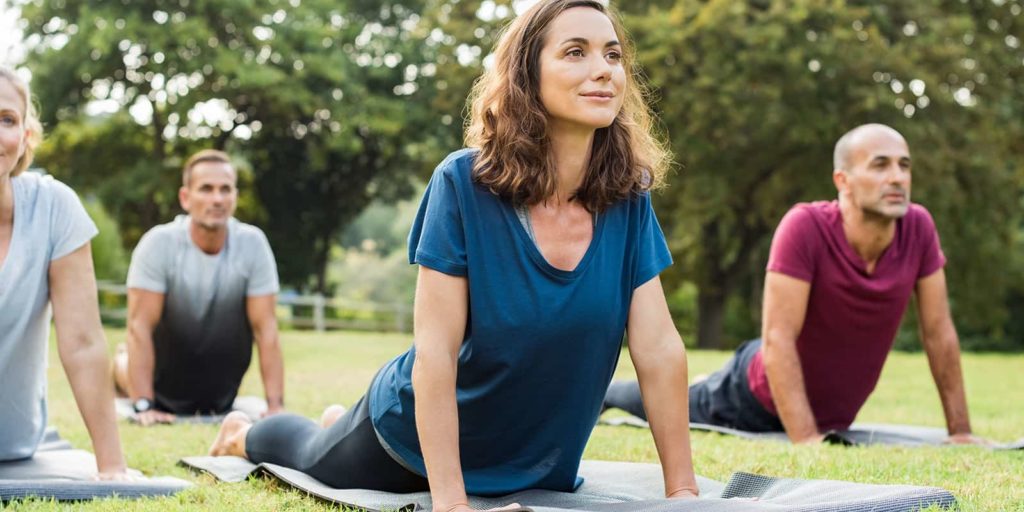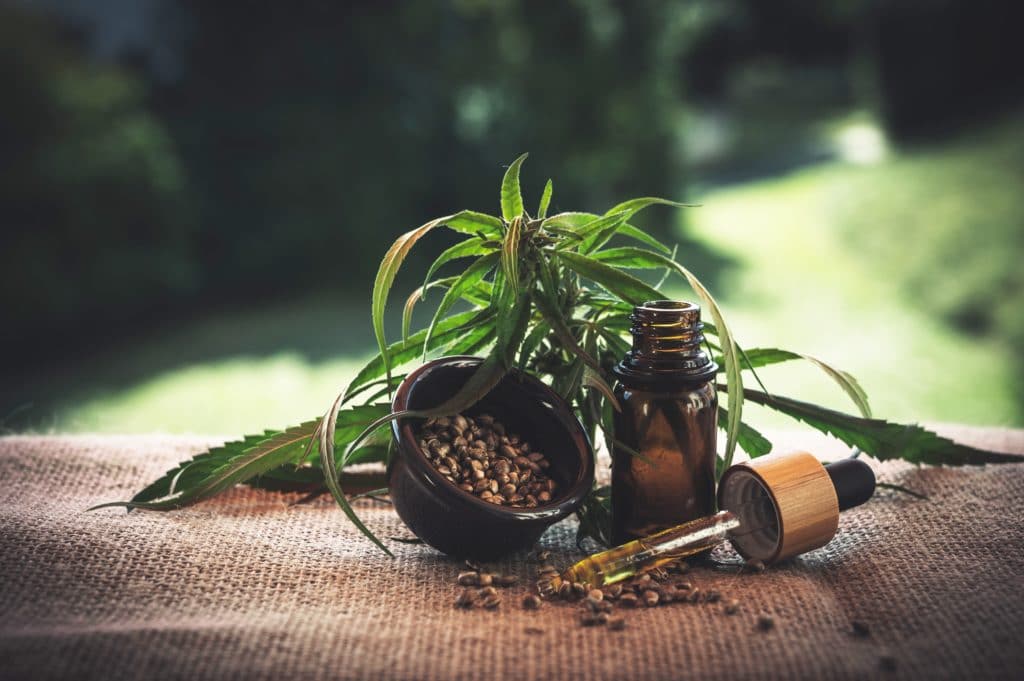“Yoga is the journey of the self, through the self, to the self.” – Hindu scripture in Sanskrit.
As we move through life we come to understand that perception, attitudes, and opinions can be difficult to change. Yet we also discover that time is often the great equalizer; what was once viewed as heretical, even subversive, can evolve into mainstream acceptance. The ancient practice of yoga is an excellent example. Over the past few decades, its acceptance has grown from the stereotypical Birkenstock-wearing counter-culture, to publicly traded yoga companies and gyms offering classes 24/7. In cities across the nation, people have traded their burger and fries for yoga mats. For many of us, it’s common to see people on their way to a class during lunch. Attitudes have indeed changed, and Western medicine recognizes yoga’s many health benefits. This same recognition is happening with the health benefits of cannabis and putting the two together can be a powerful combination for improving adult wellness and health.
Body & Soul
For its practitioners, yoga is both a physical and spiritual experience and it is based on ancient Hindu philosophies. Its core purpose is to help people calm their minds, find a higher plane of enlightenment, improve their bodies, and ease pain. There are many styles and philosophies to choose from depending on your experience, preferences, and goals. Like any exercise program, if you’re new to yoga, do your homework and ask questions before diving in (so to speak). No matter your choice, yoga provides a myriad of health and wellness benefits for women and men: increased flexibility, strengthened muscles, improved cardiovascular and respiratory functions, relief from joint pain, anxiety, depression, and better sleep. The American Osteopathic Association agrees that yoga can lessen chronic pain and help mitigate headaches, lower back pain, carpal tunnel syndrome and arthritis. They also agree that yoga helps manage the devastating effects of stress.[1]
If you’re a medicinal cannabis user, yoga’s health benefits may sound very familiar, and because yoga is a holistic form of therapy, cannabis consumption prior to a session can enhance the overall yoga experience and practice. Certain cannabis strains on their own provide heightened body awareness and sensitivity. Both cannabis use and yoga affect the parasympathetic nervous system. This is responsible for bodily functions when we are at rest in that it stimulates digestion, activates various metabolic processes and helps us to relax.[2]
Yoga 101
If you’re new to yoga, we’re happy to provide a brief overview of the concepts and styles:
- Karma Yoga is described as the path of service for the spiritual practice of selfless action performed for the benefit of others.
- Bhakti Yoga is focused on loving devotion to a personal god. It frequently incorporates chanting, prayer, and singing among other forms of expression.
- Jnana Yoga emphasizes the path of knowledge, wisdom, and intellect, or the path of self-realization. The jnana yoga is a spiritual practice with questions such as “who am I, what am I” among others.
- Raja Yoga is the “royal path” and in ancient and medieval Sanskrit texts, it meant the highest state of yoga practice.
But Wait, There’s More!
In addition to the four styles above, there are forms within these overall styles. The most common are:
Hatha Yoga: This style became popular throughout the world as a form of physical exercise and is now what many people describe simply as “yoga.” It emphasizes controlled breathing as part of the experience.
Vinyasa Flow Yoga: coordinates movement with breath (inhaling and exhaling) to flow from one yoga pose to the next. It is an extremely popular yoga practice.
Ashtanga/Power Yoga is a very physical form of yoga and again, is very popular. The goal is to develop endurance, stamina, and strength.
Anusara® Yoga is a relatively new form of yoga that emphasizes a more joyful and inclusive experience. The Anusara style emphasizes a set of Universal Principles of Alignment which underlie all of the physical poses and are connected to philosophical aspects of the practice.
Bikram Yoga® AKA Hot Yoga: As the name implies, this style is practiced under hot and humid conditions in the studio, up to 106 degrees. It was created by Bikram Choudhury and is intense, so be prepared to sweat and rehydrate!
Kundalini Yoga: This style is actually a synthesis of many traditions which may include Haṭha Yoga techniques. Practitioners traditionally wear white outfits and turbans.
Restorative Yoga: This practice generally uses only five or six poses, and a key difference with other styles is that props such as pillows and blankets are used to support the body in seated and reclining postures. The goal is complete relaxation and rest.
Yin Yoga: Gaining in popularity, Yin Yoga s a slow-paced style of with postures that are held for longer periods of time. For beginners, it may range from 45 seconds to two minutes; more advanced practitioners may stay in one asana for five minutes or more. The idea is that the style focuses on the connective tissues rather than the muscles and bones.
Acro Yoga: This is a physical practice which combines yoga, acrobatics, and Thai massage. Practitioners use a partner to form the poses. Think of balancing your partner on his/her stomach with your feet. Caution is warranted as it is more vigorous than other yoga practices and may lead to more injuries.
What’s in a Name?
The practice of using herbal and botanical medicines for meditation and yoga is a centuries-old practice. So, in effect, the use of “herb” in conjunction with yoga is not a universe-altering concept. Currently, it is known by many names. Weed Yoga, 420 Yoga, CannaYoga, and Ganja Yoga, just to name a few. Yogi and author Dee Dussault is a pioneer in combining cannabis with yoga since 2009. Based in San Francisco, her company, Ganja Yoga, provides classes, retreats, and teacher training under the philosophy of enhanced practice for relaxation, well-being, and the cultivation of inner peace. Dee believes that the practice is especially beneficial for mature adults because “this population has the most pain, inflammation, and immobility.” Her back-to-basics approach to yoga, focusing on useful movements and relaxing stretches, makes the practice accessible again, getting people moving even a little more than before. Dee believes this is the key to a long, happy life as “cannabis has been shown to help with pain, inflammation, and relaxation, and the pairing makes perfect sense.”
Balance is the Key
At the risk of sounding obtuse, it’s fairly obvious that balance is extremely important in yoga. But equally important is your consumption of cannabis prior to your session. Remember the old adage that too much of good thing is a bad thing? Well, it’s important that you know how cannabis affects you before combining it with any physical activity, let alone one in which you are in a room filled with a bunch of perspiring women and sweaty men. Caution and experimentation are crucial. For example, a friend of mine who uses edibles prefers to do so in the privacy of her home when she knows she can completely relax. If this describes you, then perhaps consuming in a public setting may not lend itself to a positive experience. Try it at home first. It is also crucial that you understand how different cannabis strains affect YOUR body. For some people, THC may cause dizziness, so again, it’s important to find a balance (pun intended) and ease into the situation. In general, Indica strains tend to have more of a calming, body-centric effect, so exploration of various strains may be helpful. On the flip side, Sativa strains may provide energy along with a sense of euphoria and well-being. Again, only you know what may work best for your body and goals. And remember, when in doubt, ask a professional budtender or your class instructor for their recommendations.
I Never Inhaled
Many of us remember the famous (and ridiculous) statement from President Bill Clinton when asked about his Cannabis use in college. For yoga, it is something to consider as an essential element of yoga is breathing. With this in mind, smoking in a yoga class may not be the best choice, and may, in fact, be prohibited depending on the setting, building, local ordinances, etc. Vaping may be an option, and in fact, organized classes my very well provide the cannabis for the class.
Controversy & The Case for Medicinal Use
The combination of cannabis and yoga is not universally accepted within the yogi professional community. There are schools of thought that yoga is a spiritual journey in and of itself, and cannabis, by altering the mind and body, brings an impurity or alteration to this path. But consider patients that might not otherwise be able to take part in yoga due to pain. Medical research is still evolving regarding the use of Cannabis as a pain reliever. If cannabis provides a pathway to help these patients, then there is no controversy. This is especially true if it helps mature adults achieve more physical activity.
To Each to Their Own
Time will tell whether combining cannabis and yoga is merely a trend. In the end, however, the decision to explore the combination of cannabis and yoga is a personal, adult choice. It is after all your mind and your body, and everyone has a different personal definition of peace, tranquility, and happiness. The beauty is that in US states where legalization has taken root, you have the ability to be flexible in body and spirit, and to keep an open mind.




